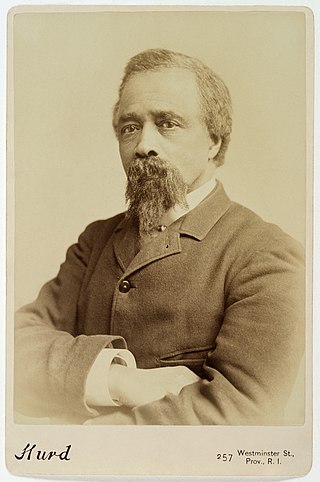
Edward Mitchell Bannister was a Canadian–American oil painter of the American Barbizon school. Born in colonial New Brunswick, he spent his adult life in New England in the United States. There, along with his wife Christiana Carteaux, he was a prominent member of African-American cultural and political communities, such as the Boston abolition movement. Bannister received national recognition after he won a first prize in painting at the 1876 Philadelphia Centennial Exhibition. He was also a founding member of the Providence Art Club and the Rhode Island School of Design.

A mural is any piece of graphic artwork that is painted or applied directly to a wall, ceiling or other permanent substrate. Mural techniques include fresco, mosaic, graffiti and marouflage.

The Frans Hals Museum is a museum in the North Holland city of Haarlem, the Netherlands, founded in 1862, known as the Art Museum of Haarlem. Its collection is based on the city's own rich collection, built up from the 16th century onwards. The museum owns hundreds of paintings, including more than a dozen by Frans Hals, to whom the museum owes its name. The Frans Hals Museum has two historic locations in Haarlem city centre: the main location on Groot Heiligland and Location Hal on Grote Markt, composed of the adjacent 17th-century Vleeshal and 19th-century Verweyhal. On Groot Heiligland is the 17th-century Oudemannenhuis with regent's rooms. It houses the famous paintings by Frans Hals and other ancient, modern and contemporary art, as well as the museum café. Location Hal regularly hosts exhibitions of modern and contemporary art.

The Baltimore Museum of Art (BMA) in Baltimore, Maryland, is an art museum that was founded in 1914. The BMA's collection of 95,000 objects encompasses more than 1,000 works by Henri Matisse anchored by the Cone Collection of modern art, as well as one of the nation's finest holdings of prints, drawings, and photographs. The galleries currently showcase collections of art from Africa; works by established and emerging contemporary artists; European and American paintings, sculpture, and decorative arts; ancient Antioch mosaics; art from Asia, and textiles from around the world.

Street art is visual art created in public locations for public visibility. It has been associated with the terms "independent art", "post-graffiti", "neo-graffiti" and guerrilla art.
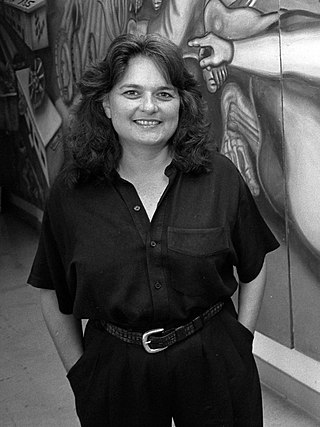
Judith Francisca Baca is an American artist, activist, and professor of Chicano studies, world arts, and cultures based at the University of California, Los Angeles. She is the co-founder and artistic director of the Social and Public Art Resource Center (SPARC) in Venice, California. Baca is the director of the mural project that created the Great Wall of Los Angeles, which was the largest known communal mural project in the world as of 2018.
The San Francisco Arts Commission (SFAC) is the City agency that champions the arts as essential to daily life by investing in a vibrant arts community, enlivening the urban environment and shaping innovative cultural policy in San Francisco, California. The commission oversees Civic Design Review, Community Investments, Public Art, SFAC Galleries, The Civic Art Collection, and the Art Vendor Program.

OSGEMEOS are identical twin street artists Otavio Pandolfo and Gustavo Pandolfo. They started painting graffiti in 1987 and their work appears on streets and in galleries across the world.

Snowplow is an abstract outdoor sculpture by American artist Mark di Suvero located on the grounds of the Indianapolis Museum of Art. The sculpture was purchased in 1975 by the Indianapolis Sesquicentennial Commission and first installed in Indianapolis, Indiana in 1977.

Uphams Corner, or Upham's Corner, is a commercial center in Dorchester, the largest neighborhood of Boston, Massachusetts. The intersection of Dudley Street/Stoughton Street and Columbia Road is the heart of Uphams Corner, and one of Dorchester's main business districts.

The contemporary Boston Arts Festival is an annual event showcasing Boston's visual and performing arts community and promoting Boston's Open Studios program. The weekend-long Festival at Christopher Columbus Waterfront Park features a wide variety of arts and high-end crafts, including painting, photography, ceramics, jewelry, sculpture and live music. The Arts Festival, which has existed in several different forms, was relaunched by former Mayor Thomas Menino in 2003, then reconceived by Mayor Marty Walsh in 2015. The Beacon Hill Art Walk and Artists Crossing Gallery will be organizing the 2019 September Festival.

Lift Off is a public artwork by American artist David Black, located at the CityVista Condominium at the intersection of 5th St NW & K St NW in the Mount Vernon Triangle neighborhood of Washington, D.C., United States. Lift Off was created through DC Commission on the Arts and Humanities.

The Chicano Art Movement represents groundbreaking movements by Mexican-American artists to establish a unique artistic identity in the United States. Much of the art and the artists creating Chicano Art were heavily influenced by Chicano Movement which began in the 1960s.
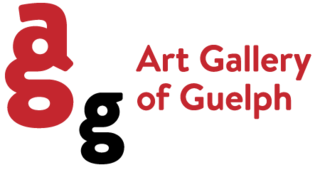
The Art Gallery of Guelph (AGG), formerly the Macdonald Stewart Art Center, is a public gallery and adjoining Sculpture garden in Guelph, Ontario. Its collection consists of over 9,000 works. The AGG is a nonprofit organization which focuses on research, publishing, educational programs, and touring exhibitions.
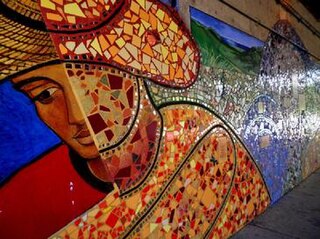
Chicago Public Art Group is a non profit cultural organization in Chicago that organizes and promotes creation of community public art. The Group was founded in 1971 and has been involved in the creation of hundreds of artworks in and around the city. CPAG supports the production of public murals, mosaics, sculptures and space designs in collaboration with community participants. CPAG also educates artists and the public about the history and possibilities of collaborative public art. Several of its works have been large bricolage mosaics in city underpasses.
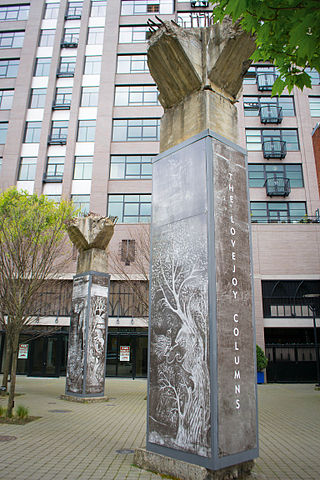
The Lovejoy Columns, located in Portland, Oregon, United States, supported the Lovejoy Ramp, a viaduct that from 1927 to 1999 carried the western approach to the Broadway Bridge over the freight tracks in what is now the Pearl District. The columns were painted by Greek immigrant Tom Stefopoulos between 1948 and 1952. In 1999, the viaduct was demolished but the columns were spared due to the efforts of the architectural group Rigga. For the next five years, attempts to restore the columns were unsuccessful and they remained in storage beneath the Fremont Bridge.
Barbara Weaver-Bosson is an artist whose paintings document the architectural character of Victoria, British Columbia. Since 1978, her paintings have illustrated Canada's West Coast urban landscape as it changes. In numerous works of art, she has created a visual and residential history of the area. Her detailed paintings document Victoria's street views, seaside neighbourhoods and harbour areas.
The Eskenazi Health Art Collection consists of a wide variety of artworks composed of fragments from the 1914 City Hospital mural and artwork project, artworks added over time, and newer pieces which include works created for the new Sidney & Lois Eskenazi Hospital and campus in 2013. Other works have been added occasionally; there are also artworks at the clinics throughout Marion County.
The conservation and restoration of outdoor murals is the process of caring for and maintaining murals, and includes documentation, examination, research, and treatment to insure their long-term viability, when desired.

Yatika Starr Fields is a Native American painter, muralist and street artist, born in the city of Tulsa, Oklahoma. His artworks were shown at numerous galleries and museums, including the APEC Young Artist Exhibition and recently in the Sam Noble Museum.
















